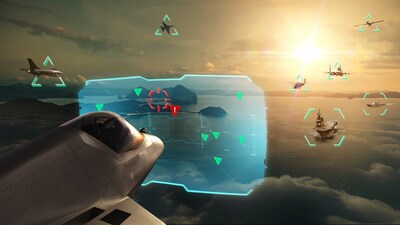New Study Reveals How Supernovae Collisions Ignite the Birth of Stars and Planets in the North Celestial Pole Loop
WASHINGTON, Oct. 16, 2023 /PRNewswire/ — In a study examining the dynamics of neutral hydrogen gas within the North Celestial Pole (NCP) Loop, scientists have uncovered an unforeseen revelation — a collision between two supernova shells has yielded the essential conditions for the genesis of cirrus dust clouds, the precursors of stars and planets as well as interstellar molecular clouds, the fundamental components of life’s building blocks. The findings have been published in The Astrophysical Journal. The lead author of the paper is Universities Space Research Association’s Astronomer Emerita, Dr. Joan Schmelz.
Supernova explosions attributed to the unseen companion of several binary star systems studied by the Gaia spacecraft may be responsible for a number of well-known and well-studied features in the radio sky including the Low-Latitude-Intermediate-Velocity (LLIV) Arch and the North-Celestial-Pole (NCP) Loop.
Radio data from the 100-m telescope in Effelsberg, Germany show multiple signatures of an expanding shell.
The source of this expansion, which includes the LLIV Arch on the approaching side, may be the neutron star candidate in a binary star system studied by Gaia. If we make the simplifying assumptions that the expansion of the shell is uniform and spherically symmetric, then the explosion took place about 700,000 years ago.
“Supernovae this old haven’t gotten much attention since most of the interesting emission has faded away,” said Joan Schmelz, “But we’re finding more and more evidence that they may be responsible for some of the interesting structure and dynamics of interstellar hydrogen clouds.”
As the supernova remnant gets to be about 100,000 years old, the X-rays, synchrotron radiation, and optical light begin to disappear, but the shell continues to expand from its own momentum. This phase lasts hundreds of thousands of years and is best seen in the radio emission from neutral hydrogen atoms studied by the Effelsberg telescope.
The hydrogen on the receding side of this shell is interacting with the gas approaching us on the near side of a second shell. The NCP Loop appears to be located at the intersection of these two expanding features. A second neutron star candidate in another binary studied by Gaia may be (in part) responsible for this shell.
We can use the primary star in each of these binaries to anchor the distances to the LLIV Arch and NCP Loop, which are ~550 and ~700 light years, respectively. This work is particularly significant because, until now, the distances to these radio clouds in the space between the stars of the Milky Way Galaxy were unknown.
“Distance is one of the most challenging measurements in astronomy,” said Gerrit Verschuur, a radio astronomer and co-author on the paper. “These hydrogen clouds were discovered 60 years ago, and for the first time, we know where they are and how they came to be.”
In order to compare the observations with models, astronomers need to calculate the fundamental parameters of the hydrogen clouds – mass, age, energy and momentum – and these calculations are impossible without knowing the distance. Only then can we verify the theoretical predictions and expand our knowledge of interstellar space.
Our results confirm that the LLIV Arch and NCP Loop are components of expanding shells with the mass, age, energy and momentum values that agree with models of aging supernovae.
Additional Resources:
Supernovae Origin for the Low-Latitude-Intermediate-Velocity Arch and the North-Celestial-Pole Loop, Schmelz, J.T., Verschuur, G.L., Escorza, A., Jorissen, A. (2023), Astrophysical Journal, 956, 2
About USRA
Founded in 1969, under the auspices of the National Academy of Sciences at the request of the U.S. Government, the Universities Space Research Association (USRA) is a nonprofit corporation chartered to advance space-related science, technology and engineering. USRA operates scientific institutes and facilities, and conducts other major research and educational programs. USRA engages the university community and employs in-house scientific leadership, innovative research and development, and project management expertise. More information about USRA is available at www.usra.edu.
© 2023 Universities Space Research Association
425 3rd Street SW, Suite 950, Washington DC, 20024
PR Contact:
Suraiya Farukhi
[email protected]
443-812-6945
![]() View original content to download multimedia:https://www.prnewswire.com/news-releases/new-study-reveals-how-supernovae-collisions-ignite-the-birth-of-stars-and-planets-in-the-north-celestial-pole-loop-301957723.html
View original content to download multimedia:https://www.prnewswire.com/news-releases/new-study-reveals-how-supernovae-collisions-ignite-the-birth-of-stars-and-planets-in-the-north-celestial-pole-loop-301957723.html
SOURCE Universities Space Research Association




 Private Internet Access gives you unparalleled access to thousands
of next-gen servers in over 83 countries and each US state. Your
VPN experience will always be fast, smooth, and reliable.
Private Internet Access gives you unparalleled access to thousands
of next-gen servers in over 83 countries and each US state. Your
VPN experience will always be fast, smooth, and reliable.

